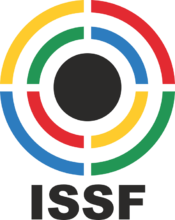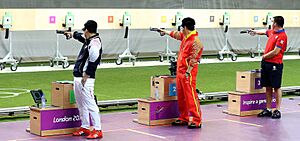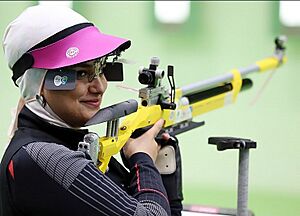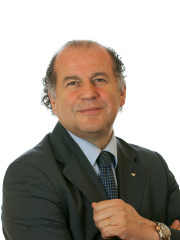International Shooting Sport Federation facts for kids
 |
|
| Sport | Shooting sports |
|---|---|
| Jurisdiction | International |
| Membership | 150 regions |
| Abbreviation | ISSF |
| Founded | 17 July 1907 |
| Headquarters | Munich, Germany |
| President | Luciano Rossi |
| Vice president(s) | Catherine Fettell John Hansen Kim Rhode Yifu Wang |
| Secretary | Alessandro Nicotra di San Giacomo |
| Official website | |
The International Shooting Sport Federation (ISSF) is the main organization for Olympic shooting events around the world. It also manages many other shooting sports that are not in the Olympics. The ISSF creates the rules for shooting, helps athletes qualify for the Olympic Games, and organizes major competitions like the World Cup and World Championships.
The ISSF was first started on July 17, 1907. After World War I, it was re-established as the Union Internationale de Tir (which means International Shooting Union). In 1998, its name changed to the International Shooting Sport Federation, which it is still called today. The Federation works with over 150 national shooting groups. Its main office is in Munich, Germany. Since 2022, the president of the ISSF has been Luciano Rossi.
After the 2022 events in Ukraine, the ISSF did not allow athletes and officials from Russia and Belarus to compete. In March 2023, the new president, Luciano Rossi, said he hoped these athletes could compete again at the 2024 Summer Olympics in Paris.
Major Shooting Competitions
The ISSF organizes and recognizes several important shooting competitions:
- The Olympic Games: These happen every four years and include only Olympic shooting events.
- The ISSF World Shooting Championships: These take place every four years. For shotgun events, they happen every two years.
- The ISSF World Cup: This competition happens four times a year, with a final event at the end. It includes only Olympic shooting events.
- The ISSF Junior World Cup: This is also held four times a year with a final, for younger athletes in Olympic events.
- Regional championships: These are held in different parts of the world, like the European Championships or the Pan-American Games.
These are the only competitions directly overseen by the ISSF. They are also the only places where new world records can be officially set.
| Number | Events | First | Last |
|---|---|---|---|
| 1 | World Championships | 1897 | 2023 |
| 2 | World Cup | 1986 | 2024 |
| 3 | Junior World Championships | 2017 | 2021 |
| 4 | Junior World Cup | 2016 | 2022 |
| 5 | World University Championships | 2003 | 2018 |
| 6 | World Military Championships | 1957 | 2017 |
Types of Shooting Sports
The ISSF has five main types of shooting sports: Pistol, Rifle, Shotgun, Running Target, and Target Sprint. Running Target and Target Sprint use rifles, but they are different from regular rifle events. Running Target uses targets that move, and Target Sprint combines shooting with running, similar to biathlon.
This section only lists the main types of shooting. Many of these have separate events for men and women, or team competitions.
Pistol Shooting
In ISSF Pistol events, shooters use either cartridge pistols or air pistols. They shoot at targets that are black circles with scoring rings. In timed events, targets used to turn, but now they stay still. Lights (red and green) tell shooters when they can fire. If a shot is fired too early or too late, electronic systems will ignore or penalize it.
Olympic Pistol Events
- 10M Air Pistol: A slow, precise event using a .177 calibre air pistol.
- 25M Pistol: A timed event for women, shooting at a single target with a .22lr pistol.
- 25M Rapid Fire Pistol: A fast-paced event for men, shooting at five targets with a .22lr pistol.
Other Pistol Events
- 25M Center-fire pistol
- 25M Standard Pistol
- 50M Pistol: A slow, precise event using a .22lr pistol.
Rifle Shooting
ISSF Rifle events use both cartridge rifles and air rifles. Shooters aim at static black circle targets, and points are given based on where the bullet hits the scoring rings.
Olympic Rifle Events
- 10M Air Rifle: A slow, precise event using a .177 calibre air rifle.
- 50M Three-Position Rifle: A slow, precise event using a .22lr rifle. Shooters shoot from three positions: kneeling, prone (lying down), and standing.
Other Rifle Events
- 50M Prone Rifle: A slow, precise event using a .22lr rifle while lying down.
- 300M Prone Rifle: A slow, precise event using a larger calibre rifle while lying down.
- 300M Three-Position Rifle: A slow, precise event using a larger calibre rifle from kneeling, prone, and standing positions.
Shotgun Shooting
In shotgun events, shooters use shotguns to hit flying targets called clay pigeons.
Olympic Shotgun Events
- Skeet
- Trap
Other Shotgun Events
- Double trap
Running Target Shooting
ISSF Running Target events use rifles, either cartridge or air rifles. The targets are black circles that move. Points are scored based on where the shot hits the rings. Running Target events are not part of the Olympic Games.
- 10M Running Target: Uses a .177 calibre air rifle.
- 50M Running Target: Uses a .22lr rifle.
Target Sprint
Target Sprint uses .177 air rifles. Shooters aim at static black circle targets, and points are based on hits or misses. This sport is similar to Biathlon because it combines running with shooting. However, in Target Sprint, all shooting is done standing, and athletes do not carry their rifles while running. Rifles are left on a rack at the shooting spot. Target Sprint is not an Olympic event.
History of the ISSF
How Shooting Sports Began
Target shooting sports became very popular in the late 1800s. This happened partly because countries wanted to make sure their citizens were good at shooting for national defense. Groups like the National Rifle Association in the UK were formed to encourage shooting skills. Soon, target shooting became a popular hobby and sport around the world.
Early Olympic Games and the ISSF
Shooting was part of the very first modern Olympic Games in Athens in 1896. Many shooters from different countries competed.
On July 17, 1907, representatives from seven national shooting groups met in Switzerland. They officially created the International Union of National Shooting Federations and Associations. This meeting is considered the first ISSF General Assembly. Daniel Mérillon from France was chosen as the first president.
More countries joined the Union over the years. In 1912, many athletes from 16 countries competed in shooting at the Olympic Games. However, World War I caused the Olympic Games and all international shooting events to stop. The Union also closed down in 1916.
In 1920, Daniel Mérillon helped restart the organization. Delegates from 14 countries met in Paris and agreed to re-establish it as the L'Union Internationale de Tir. Mérillon was re-elected president. Later that year, shooting was back in the Antwerp Olympic Games. In 1921, the International Olympic Committee (IOC) decided that the ISSF's rules would be used for Olympic shooting events. This was a big step in connecting the ISSF with the Olympics.
There was a disagreement between the ISSF and the IOC in the late 1920s. The ISSF gave money prizes in its championships, which went against the IOC's strict rules about amateur athletes (meaning athletes who don't get paid). Because of this, shooting was not included in the 1928 Games. After some discussion, shooting was brought back for the 1932 Olympics, but with fewer events. In 1937, Catherine Woodring became the first woman to compete in a UIT World Championship event.
World War II caused another break in the Olympic Games and shooting events. After the war ended in 1947, a World Championship and a meeting were held in Sweden. Erik Carlsson became the third president of the ISSF.
Later 20th Century Developments
Shooting was included in new multi-sport events like the Pan-American Games and the Asian Games, starting in 1951. Since 1954, the ISSF began holding its World Championships every four years. In 1966, the UIT decided that women could compete alongside men in all official competitions, including the Olympic Games.
In 1980, Olegario Vázquez Raña from Mexico was elected president of the ISSF. He was an active shooter who had competed in many Olympic Games and World Championships. Under his leadership, the ISSF grew and made important changes to its rules and organization. In 1984, Unni Nicolaysen became the first woman elected to the ISSF's main council. That same year, the IOC added three women's events to the Olympic shooting program.
Two years later, the ISSF created a system for athletes to qualify for the Olympics. They also started a new series of World Cups, where athletes could set world records. The first ISSF Rifle and Pistol World Cup was held in Mexico City in 1986. Since then, the ISSF World Cup has been held every year, leading to a final competition for the top shooters. In 1994, 25 junior events were added to the championship programs.
In 1998, the word "Sport" was officially added to the Federation's name, making it the International Shooting Sport Federation. Between 1996 and 2000, three more women's events were added to the Olympic program.
21st Century and Recent Changes
At the 2004 Olympic Games in Athens, 390 shooters from 106 countries competed. The ISSF celebrated its 100th anniversary on July 17, 2007. It started with just two shooting events and grew to include 15 Olympic and 23 World Championship events.
In 2008, at the Beijing Olympics, 390 athletes from 103 countries competed in 15 shooting events. The first gold medal of those Games was won by Kateřina Emmons, a Czech shooter, in the 10m Air Rifle Women event.
In 2018, Olegario Vázquez Raña stepped down after being president for 38 years. Vladimir Lisin from Russia was elected as the new president. He started a fund to help develop shooting sports in different countries and support athletes.
In November 2022, Luciano Rossi was elected as the new ISSF President. He took over from Vladimir Lisin. On December 1, Rossi appointed Willi Grill from Germany as the new Secretary-General. In March 2023, Rossi again said he wanted Russian and Belarusian athletes to be able to compete as neutral athletes in the 2024 Summer Olympics in Paris. In December 2023, Willi Grill was replaced as Secretary General.
Shooting at the Commonwealth Games
In 2018, shooting was removed from the program for the 2022 Commonwealth Games. Shooting had been included in every Commonwealth Games since 1974. The ISSF tried to get shooting back into the Games, but it was not successful for 2022.
In 2022, the organizers for the 2026 Commonwealth Games also did not include shooting in their first plan. However, the ISSF worked to get it added. In October 2022, it was confirmed that shooting would be included in the 2026 Games, but with a smaller number of events.
Luciano Rossi was elected as ISSF President at the 70th General Assembly on November 30, 2022.
See also
 In Spanish: Federación Internacional de Tiro Deportivo para niños
In Spanish: Federación Internacional de Tiro Deportivo para niños
- List of shooting sports organizations
- ISSF World Shooting Championships
- Shooting at the Summer Olympics







